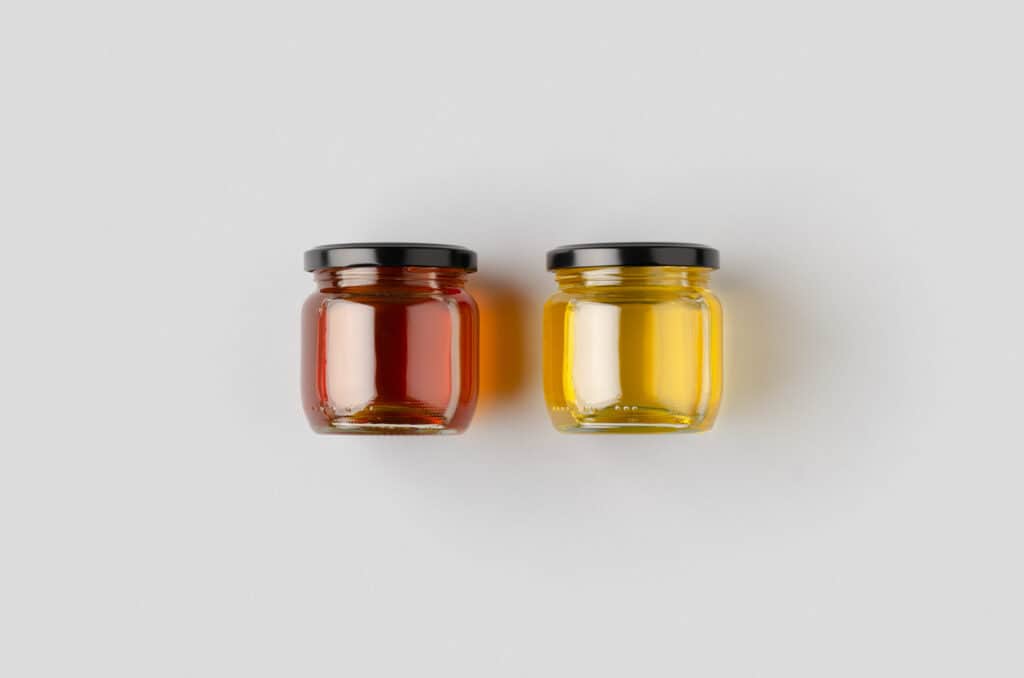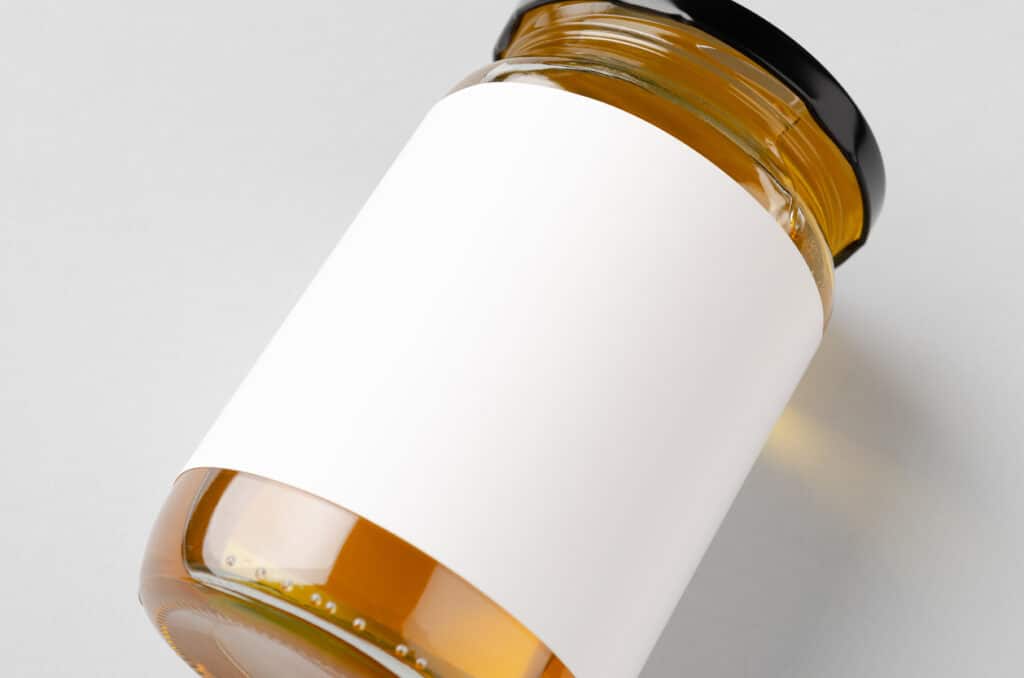The resilient fireweed plant is often referred to as a phoenix rising from the ashes. The fireweed plant is one of the first flowers to emerge after a devastating fire -living proof that charm and beauty can emerge from ashes. Along with its charisma, fireweed offers rich nectar irresistible to bees, producing the delicate, mouth-watering “Champagne of honey.”
Fireweed honey is a scarce, monofloral honey product produced by honeybees harvesting and converting fireweed flowers’ nectar into honey. Fireweed honey is mild, nearly transparent honey with a distinct floral and smooth buttery taste. It also has powerful antibacterial properties.
Fireweed honey is incomparable to the mass-produced, bear-shaped plastic containers of amber liquid. Read ahead to decode why fireweed honey earns so much praise throughout the honey sommelier world.
What Is Fireweed Honey?

As the name suggests, fireweed honey is “liquid gold” sourced from the fireweed plant.
Fireweed honey is a mono-floral varietal, famed as the “Champagne of honey.” This rare honey is produced by honeybees harvesting the nectar of fireweed flowers and converting it into delicately sweet-tasting honey with medicinal qualities.
Sadly, pure, raw fireweed honey is tough to harvest due to the plant’s short blooming season and limited honey supply -its price reflects the reality of this scarce, coveted honey.
Wildflowers shortly appear after fireweed blossoms spring forth. Hence, honeybees can end up pollinating other nectar sources. The few beekeepers willing to face the many complications of maintaining dense fireweeds areas and harvesting pure fireweed honey sell the product at premium prices.
Contrary to its fiery name, fireweed honey has a delicate, fruity flavor with a smooth, buttery finish. In addition, it has a light amber, almost transparent color with an occasional green tinge.
Where Does Fireweed Honey Come From?

Fireweed is an herbaceous perennial plant from the willowherb family. It is native throughout the temperate regions of the Northern Hemisphere.
This resilient plant provides charming clusters of vibrant pink or purple blossoms with a prolific food source of rich nectar for honeybees.
You’ll commonly find fireweed honey in cool climates, particularly in Alaska and the Northwestern United States. However, you’ll also find fireweed honey across the pond in northern European countries like Britain, Canada, Denmark, Finland, Norway, and Sweden.
Fireweed flowers bloom for a short period, making a limited, premium honey harvest, often bringing a high price.
How Is Fireweed Honey Made?
Fireweed primarily inhabits disturbed areas like burned forests, swamps, river bars, waste places, and old fields. Raw, unpasteurized fireweed honey is made from honeybees situated around acres of fireweed fields.
Fireweed honey starts as alluring flower nectar, which honeybees collect. The nectar mixes with the bees’ enzymes (invertase). Once the bees return to the hive, they pass the gathered nectar between themselves, mixing the nectar with invertase to reduce the water content and convert the nectar into simple sugars that the bees store inside the honeycomb.
The unique honeycomb design and constant fanning of the bees’ wings speed up evaporation, converting the fireweed nectar into sweet “champagne honey” capped with a protective waxy layer.
Beekeepers can filter raw fireweed honey to remove more prominent, unwanted elements like dead bees, pollen, propolis, beeswax, or small honeycomb chunks that tend to upset the texture of the honey.
The Challenges Of Making Fireweed Honey
Despite fireweed being an invasive flower and one of the first plants to bloom on cleared land, wildflowers happen to bloom shortly after the fireweeds. With the diversity of flowers available, the bees pollinate all the nectar sources they can find, making it exceptionally challenging for beekeepers to ensure pure fireweed honey. Separating the fireweed honey from other wildflower honey deems nearly impossible.
Another challenge of producing fireweed honey is that the plants become crowded by other trees and shrubs, reducing the fireweed blooms. So, a beekeeper can experience a noteworthy honey crop for several years; however, the fireweed plants can decrease during the following years.
Some beekeepers go as far as trying to chase fireweed honey by scouting out and planting their hives near locations where fires occurred. While this lucrative strategy might bring in a good crop, the beekeepers have to move their bees further north to remote forest regions inhabited by bears that can disturb the hives.
The limited honey supply and list of complications beekeepers face when producing fireweed honey certainly set a hefty price for their crop.
What Does Fireweed Honey Taste Like?
Fireweed honey is light, fresh, and flavorful -nothing like the amber liquid found in the honey bear bottle of your childhood days.
Fireweed honey will indulge you with its smooth, lingering fruity flavors and delightfully buttery finish that entices you to lean in for a second spoonful. In addition, it can lend a sharp, almost peppery flavor with an overly sweet taste.
You’ll luxuriate in the unique flavorsome layers as the honey hugs your tongue like a cozy blanket -a true love affair. The fireweed honey also offers a distinct floral essence that you can almost taste.
Lastly, fireweed honey has a spreadable crystalline texture perfect for spreading on toast or drizzling over yogurt.
Is Fireweed Honey Dark Or Light?

Fireweed honey is exceptionally pure with a light amber to nearly transparent color. However, this honey can develop a greenish tint in some regions.
Fireweed honey is lighter than wildflower honey and turns even lighter after crystallization.
Is Fireweed Honey Seasonal?
Fireweed blossoms have a concise life span, each flower lasting only 48 hours.
Fireweed plants reach their bloom peak by late July to early August. Unfortunately, their limited bloom period makes fireweed honey scarce and pretty expensive.
Is Fireweed Honey Healthy?
The fireweeds plants aren’t only a high-value food source for bees, but the shoots are deemed safe and healthy for human consumption. Due to the plant’s medicinal properties, it’s of no surprise that honey abounds with health benefits. However, it has similar carbohydrates to most honey varieties, so we recommend enjoying it in moderation.
Bee products, including raw honey, beeswax, and propolis, have many antibacterial, antimicrobial, anti-inflammatory, and antioxidant properties. However, once processed and heated, the honey loses most of its healthy enzymes and nutrients.
Raw honey can be a potent remedy. It includes a high concentration of ascorbic acid, pantothenic acid, riboflavin, niacin, and minerals like calcium, copper, iron, zinc, potassium, magnesium, and manganese.
Honey is a superb source of flavonoids and potent antioxidants with anti-inflammatory and immune system benefits. In addition, it is an excellent source of enzymes. Wildflower honey is antibacterial, antimicrobial, antiseptic, antifungal, and even kills resistant bacteria, including MRSA.
Fireweed honey is enriched with flavonoids, potent antioxidants, and nutritious enzymes. More so, it offers antibacterial, antiseptic, and anti-inflammatory properties. In addition, fireweed honey works wonders for your skin!
Fireweed Honey Benefits
Here’s an in-depth overview of fireweed honey’s benefits.
Note: these health benefits listed below are solely based on raw, unprocessed fireweed honey:
Fireweed Honey Treats Wounds & Burns
Years ago, raw honey was a mainstay item in field hospitals and infirmaries before discovering penicillin. Untreated honey is full of antibacterial properties that aid in detoxification while warding off harmful bacteria in the liver.
Like most honey, fireweed honey is antibacterial and can promote wound healing by drawing out the excess moisture, helping to eliminate harmful bacteria.
Fireweed honey’s natural sugar and low pH help minimize or prevent harmful bacteria and microbes from infecting and multiplying in a wound. You can use fireweed honey to treat cuts, skin irritations, burns, and scarring.
Fireweed Honey Is Anti-Inflammatory
Fireweed honey contains strong anti-inflammatory properties. Therefore, it can treat infected wounds when you apply it topically. However, it positively affects gastric ulcers, arthritis, lupus, and other inflammatory-related conditions when ingested.
Fireweed Honey Is Full Of Antioxidants
Fireweed honey’s excess antioxidants help ward off the free radicals roaming around and harming the healthy cells in your body. Thus, fireweed honey can help decrease inflammation, diseases, and more.
Antioxidants like flavonoids and phenolic acid help neutralize the reactive oxygen species in your body, building up cells and causing damage that can contribute to premature aging, type 2 diabetes, or heart disease.
Fireweed Honey Promoted Cardiovascular Health
Raw fireweed honey contains propolis, a resin that bees produce from sap-producing trees and plants. The propolis can help to positively affect cholesterol and triglyceride levels, lowering LDL (bad) cholesterol by 6 to 11% while increasing HDL (good) cholesterol by 3%. In addition, fireweed honey can reduce triglyceride levels by 11%.
Raw honey may also help lower your blood pressure, improve the fat cell level in the blood, regulate your heartbeat, and prevent the early death of healthy cells. All these integrated factors play a role in improving your heart function and overall health.
There are also promising results that show that raw honey can protect your heart from oxidative stress
Fireweed Honey Promotes Healthier Skin
Thanks to the impressive antibacterial and anti-inflammatory properties of fireweed honey, you can use it as an evening face mask to moisture your skin or treat various acne or dermal problems.
Other Less Remarkable Health Benefits Of Fireweed Honey
- Iron supplement
- Improves digestion and eases constipation
- Soothes a sore throat
- Strengthens the immune system
- Can improve anemia
- Safe for people with diabetes (in moderation)
Raw Fireweed Honey Skin Benefits
Like other raw honey, unprocessed fireweed honey is jam-packed with antioxidants deemed highly effective and beneficial for your skin.
Fireweed honey can improve skin conditions like acne, eczema, and psoriasis. The antibacterial benefits of raw honey balance your skin’s bacteria while inhibiting harmful bacterial growth.
Raw fireweed honey can also be an ideal spot treatment, facemask, or skin exfoliant that removes dull, dead, dry skin while leaving your skin hydrated and rejuvenated.
Lastly, raw honey can help control unwanted facial wrinkles and fine lines by offering your skin the proper nourishment to stay healthy. The antioxidants and nutrients help repair the skin.
How Long Does Fireweed Honey Stay Fresh?
Pure, fireweed honey does not go bad. In fact, honey is recognized as the only food that doesn’t spoil. It will, however, crystallize (becoming thick and cloudy) over time.
Pure honey is something of a genuine oddity in that it does not spoil over time. The oldest known honey sample was found in an Ancient Egyptian tomb, dated around 3000 years old, and was still perfectly edible.
What gives honey this unusual property?
Honey contains unique properties that aid in its longevity, including:
- A high sugar and low moisture content
- An acidic nature
- Antimicrobial enzymes
Fireweed Honey Has A High Sugar And Low Water Content
The moisture content of fireweed honey is the vital factor that prevents it from spoiling.
Fireweed honey has a low water activity with an average of 16 to 17% water content. Therefore, fireweed honey’s moisture levels are insufficient for bacteria and fungi to grow and reproduce, making it a sterile environment to support microbial growth altogether.
Fireweed honey contains between 42 to 45% fructose and 30 to 33% glucose. The high sugar content also aids in inhibiting microbial growth like bacteria and fungi.
Fireweed Honey Is Acidic
Fireweed honey’s low acidity helps avoid spoilage.
Fireweed honey has a low pH of around 3.8 to 3.9. Its acidic pH is primarily from gluconic acid and smaller doses of formic acid and citric acid produced through the unique bee enzymes during nectar ripening.
Harmful bacteria prefer growing in a neutral rather than acidic environment. So, the acidic pH of fireweed honey hinders harmful bacterial growth. In addition, honey’s antibacterial properties are potent enough to use as an effective wound dressing.
Fireweed Honey Has Antimicrobial Enzymes
Honeybees synthesize enzymes that secrete glucose oxidase during honey production, acting as a natural preservative.
The glucose oxidase preserves the honey by converting the sugars into gluconic acid while producing hydrogen peroxide, a contributing compound to the antibacterial properties of honey.
Does Fireweed Honey Crystallize?
Fireweed honey generally takes a while to crystallize, thanks to its relatively low sucrose content. However, you may notice that, over time, your fireweed honey will start to crystallize and solidify.
When the fireweed honey eventually does crystallize, its color turns even lighter. The honey can turn extremely white, resembling cream or lard, forming grainy or snowflake clots.
Due to fireweed honey’s low water content, we can view it as a highly saturated solution of various sugars. Over time, the glucose sugars start to precipitate out of the honey solution, forming solidified crystals. However, despite the crystal formations, the honey is still perfectly fine to eat -crystallization does not constitute honey spoilage.
Immerse the fireweed honey in warm water for several minutes to revert it to its liquid form.
How To Store Fireweed Honey Correctly?
Fortunately, honey is straightforward to store and preserve correctly. To ensure your honey lasts a lifetime, consider applying the following storage tips to store your fireweed honey correctly:
- Keep your honey in a cool, dry area away from direct sunlight and preferably between 50 to 70°F. Although it’s safe to store honey in your refrigerator, it’s prone to crystallize faster.
- Store the fireweed honey in an airtight container. Consider storing the fireweed honey in a glass jar instead of plastic. Plastic containers can’t wick away moisture. In addition, steer clear of metal containers as they will oxidize.
- Avoid contaminating your fireweed honey with dirty utensils that can allow bacterial, yeasts, and fungal growth.
- Prevent overheating the honey while warming it once crystals form. Overheating will degrade the color and flavor.
- Avoid exposing moisture to your honey to prevent fermentation.
Crystallization occurs much faster at low temperatures. So, when the temperature drops below 50°F, it will accelerate the crystallization process. While you cannot entirely prevent raw, unheated honey from crystallizing, you follow steps to slow down the process.
Fireweed Honey Pairings
Fireweed honey is one of the finest honey varieties in the world.
The delicate flavor profile pairs well with pretty much anything. For example, fireweed honey is suitable for glazing meat, barbecue sauces, or smoking meat.
You can create a healthier version of your favorite recipe by replacing sugar or syrup with fireweed honey. Otherwise, enjoy a delicious, warm cup of tea with a generous teaspoon of fireweed honey, or use the honey as a sugar substitute for your cup of joe.
Fireweed’s smooth texture and subtle fruity and floral flavors make it ideal for drizzling on pancakes, waffles, bagels, or toast. In addition, pair fireweed honey with various cheeses -you’ll be surprised at how well they complement one another.
Raw Fireweed Honey vs. Regular Processed Honey
Growing up like most sweet-loving Americans, you’d be familiar with drizzling honey from a generic plastic bear. However, the syrupy sweetener you grew up with and true raw honey are incomparable!
Regular processed honey contains a homogenized version of honey from various varieties, boiled down to distill the unique, vibrant flavors into a consistently sweet honey syrup with consistent color and viscosity.
Pasteurizing honey undergoes filtering, heating, and pasteurization processes that destroy the nutritional properties of honey.
In comparison, fireweed honey sold in its raw, unfiltered form retains its delicate fruity flavors and floral aroma. The fireweed honey remains a potent superfood jam-packed with vitamins, minerals, and beneficial enzymes.
Fireweed honey’s exact taste and color can also differ depending on the “terroir,” the ever-changing environmental factors. The region, season, and climate change every year, making every drop of honey truly taste unique based on the particular place the fireweed honey was harvested.
Who Should Avoid Fireweed Honey?
Avoid consuming fireweed honey if you have any allergies related to honey or fireweed plants.
Furthermore, avoid giving fireweed honey (including all kinds of raw honey) to children under a year old. Raw honey can cause Infant Botulism, a rare but severe disease caused by a specific bacterium occasionally present in honey. However, children over a year old tend to have a more robust immune system, reducing the risk of developing Infant Botulism from eating raw honey.
You should also note that the North American and northern Europe fireweed honey is not the same as the firewood honey sold in Australia. While the American and European fireweed plants have pink or purplish blossoms, the Australian variety looks like yellow daisies. In addition, there are several warnings issued mentioning that Australian fireweed contains pyrrolizidine alkaloids toxins that can contaminate the honey. So, please check the labels carefully.
Is Fireweed Honey Vegan-Friendly?
Like most honey varieties, strict vegans do not consider fireweed honey vegan-friendly. However, this topic deems controversial among many individuals.
While the Vegan Society believes that all honey, including corn honey, is not vegan-friendly due to many commercial bee farmers employing unethical practices according to strict vegan standards, many self-proclaimed vegans are comfortable purchasing honey from “natural beekeepers.” The natural beekeepers only remove the excess honey while leaving the hive and bees undisturbed.
Fireweed syrup made from infused fireweed blossoms, water, and sugar is a vegan-friendly substitute for fireweed honey.
Is Fireweed Honey Expensive?
Fireweed honey is a gourmet honey that commands a premium price. However, you’ll need to pay particular precaution to the labels as many products aren’t 100% fireweed honey.
Due to true fireweed honey’s scarcity and expensiveness, many manufacturers create a substitute product and label it as “fireweed honey.” In addition, some manufacturers boil fireweed blossoms in a mixture of sugar and water to create a sugary syrup that resembles the flavor profile of fireweed honey.
Then, some unscrupulous sellers deliberately infuse other honey varietals with the extracted flavor of boiled fireweed blossoms. These cheaper honey alternatives are sold as fireweed honey. However, the nock-offs contain a high water content and a lower mineral quantity.
Both products, as mentioned earlier, contain nowhere near the same quality and benefits as natural fireweed honey.
Conclusion
If this article isn’t enough to convince you to try the “Champagne of honey,” we sure do not know what will change your mind!
Although costly, we can guarantee a spoonful of fireweed honey will change your pancakes or bagels into a restaurant-quality brekkie. Warning: Your days of purchasing bear-bottled honey will be over for good!

